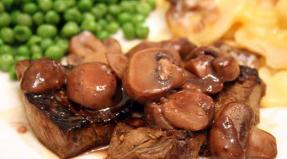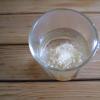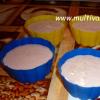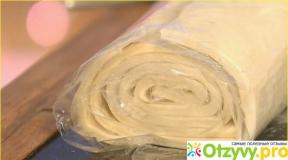French baguette recipe. Traditional French baguette: cooking secrets and recipe
How long have I wanted to bake a real French baguette! This delicious long crusty bread with a soft center makes beautiful little sandwiches and just delicious!
For a long time I walked around the bush about recipes, it all seemed that a baguette at home is difficult. But I was asked to make French onion soup. And, as you know, toast is served with French baguette with cheese! But there was no long bread in the store, and serving croutons from ordinary bread would be inauthentic ... And so I decided - since the baguette is not in the store, I will still bake it at home!

And it turned out that baking a homemade baguette is quite a simple matter, but on the contrary, very simple and pleasant. In general, baking homemade bread is an incomparable enjoyable experience! Fiddling with bread dough is more mysterious than with pies and cakes, you feel like a sorceress and a real Keeper of the Hearth!

After studying a few recipes, I learned that baguettes are different! Rice (who would have thought that boiled rice can be added to the dough!), Onions (mmm ... we'll try them again!), But for the first time I decided to bake a simple baguette. Flour, yeast, water, salt and sugar - that's the whole set of ingredients, and what a delicious bread it turns out!
Most baguette recipes use dry yeast, but since I prefer fresh yeast, I simply didn't have dry yeast. Then I did a good search, and - hurray! - we managed to find a recipe on the Magic Food website, where the dough is kneaded with fresh yeast. Moreover, it is kneaded in an unusual way. If I'm used to the fact that fresh yeast is ground with sugar and diluted with water, then in this recipe they crumble right into flour! This is a recipe from French baker Richard Bertinet. Very interesting. Let's try!
If you have dry yeast, I recommend baking baguettes according to the recipe of my friend Marie on her website: http://receptimari.com/vipechka/nesladkaya-vipechka/xachapuri-pizza-chebureki/frantsuzskiy-baget-v-duhovke.html
I have reduced the amount of ingredients a little, because I had not 20, but 15 g of yeast. I am giving my own version and in parentheses - the original one.

Ingredients:
For 3 baguettes:
- 15 (20) g fresh yeast;
- 3 and ¾ (5) glasses of flour (my glass is 200 grams, it holds 130 g of flour, if no top);
- 300 (400) ml of warm water (38C);
- 1 small top (1.5) teaspoon of salt
- A pinch of sugar;
- A little vegetable oil for greasing hands, bowl and table.
How to bake:
Take a large enough bowl and sift all the flour there.

The flour is enriched with oxygen, which the yeast needs for good fermentation, becomes airy!

And now right into the flour, crumbling fresh pressed yeast with our hands, trying to make the crumbs smaller.

Salt and sugar.
And we grind the yeast and flour with our fingers to small fluffy crumbs, sort of like we grinded flour with butter for shortbread cookies. Only the finer, the more homogeneous, the better for the yeast to mix well with the flour. Collect the grated yeast in a bunch on the top of the flour slide.
Now we make a depression in flour with yeast - sort of like a volcano crater - and pour water into it. The water should be well warm, but not hot.

Mix the dough first with a fork.

Then, sprinkle the table with flour, put the dough from the bowl there and continue to knead on the table.
There are several important nuances here:
- The dough should remain a little sticky. Do not add a lot of flour, and then the baguette will turn out to be airy and soft!
- And so that the dough does not stick too much to your hands and table, grease them a little with vegetable oil. Just do not overdo it, a thin layer is enough. At first I sprinkled a little flour on the table twice, and then greased the table with butter, and the dough stopped sticking, it was very pleasant to knead.
- And another important point - we will knead for a long time, at least 15, and better - 20 minutes. But it only seems like a long time. I used to rush all the time, and at first I thought, wow, knead the dough for 20 minutes! Yes, so much can be done during this time! But it is necessary to knead the dough properly - then it will rise well, and the bread will turn out to be fluffy and soft, even if there are no eggs or butter in it. And then, in the process of kneading, the dough becomes homogeneous, smooth, and even without adding flour it stops sticking.
Here is the dough at the beginning of the kneading:

In 5 minutes:

And after 10 minutes:

It turned out to be very pleasant - not to rush anywhere, knead a warm, pleasant dough and think about something, looking out the window at the spring rain. After all, sometimes we do not have enough time to just relax and think about something of our own - so, try kneading yeast dough, this is great relaxation!
After 15-20 minutes, put the dough in a bowl greased with vegetable oil, cover with a clean towel and put in a warm place for an hour and a half.

As time passes, the dough will come up and begin to get out of the bowl.

We will crush the table with flour and dump the dough from the bowl onto the table. No need to cheat!

Just divide the dough into 3 pieces (if you bake a full portion, then into 4).

We form a rectangle from each lump of dough by stretching it with our hands. The rectangular cake will be small, smaller than a sheet of A4 paper - but do not worry, in the process of forming the baguette will turn out to be the length of the entire baking sheet.

Now bend one edge of the rectangle towards the center.

Then we fold the second edge to the middle in the same way.

Fold the workpiece in half (that is, in general, fourfold), and pinch the edge.


Now let's roll a baguette on the table to make a sausage. Try to keep it the same thickness along the entire length. I did not fold one of the baguettes, but simply rolled the dough into a roll and pinched the edges.

Place the first baguette on a floured baking sheet and form the second and third loaves. We spread them on a baking sheet at a distance of several centimeters from each other, just three things fit.

We cover with a towel and put in a warm place for half an hour. I turned on the oven at 50C to warm up, opened the door, and put a baking sheet with baguettes on top of the stove.
After a quarter of an hour (that is, 15 minutes before you put the baguettes in the oven), make diagonal cuts on them - with a sharp knife obliquely. Cover with a towel again and let the oven heat up to 200-220C.

Now one more nuance from another French chef, chef Laszlo Gyomrey (I could not find the transcription, so I am giving the name in the original). Marie shared this advice, thank you so much! Otherwise, my baguettes would have turned out to be non-gnawed. 🙂
Before putting the baguettes in the oven, heat a cast-iron pan on the stove (the handle is also cast-iron, so as not to melt), and put the hot pan into the oven. Then we put a baking sheet with bread. Pour a glass of cold water into the pan (be careful, steam!). And close the oven door.
And the site Magic Food advises, before putting the baguettes, to spray the walls of the oven from a spray bottle, just keep in mind that the "pshikalka" should be food, not from under the "Mr. Muscles", but the one from which you spray indoor plants. Spraying can be repeated several times during the baking process so that the crust on the bread does not dry out.
I also added water to the pan twice as it baked (towards the end of baking, at the beginning I tried to look less in order to make the baguettes fit well).
We bake the baguettes for 30-35 minutes at 220C, until golden brown.

Hurray, now they are ready, our baguettes! And so that the crust on them softens a little, I covered them with a towel while still hot, after sprinkling the baking sheet and the bread itself with boiled water. 5-7 minutes - and the crust is soft, but crispy!

And what a lush, tender crumb!

How delicious and aromatic they are! Homemade baguettes turned out to be a hundred times tastier than purchased bread! We barely waited for them to cool down a bit to try.
It's great to bake bread at home! And after the baguettes at home, I wanted to learn something else. Maybe a different kind of baguette, or maybe bread with a mixture of cereals, or rye-wheat! Come to the light, let's try together!

Let's prepare the flour for now. Sift 750 grams of white flour into a mixer bowl, add 3 teaspoons of salt, mix. Baguette dough can be kneaded manually or with a kneader, we use a kneader. 10 minutes have passed, we mix the yeast and proceed to kneading the dough. Stirring with a mixer at low speed, gradually add the yeast to the flour. Without stopping stirring, gradually add the dough prepared the day before. We knead the dough, the dough must be kneaded well. Transfer the finished dough to a bowl, cover with plastic wrap and leave at room temperature for proofing for 1-1.5 hours. In this case, the dough should increase in volume by 4-5 times.

Put the matched dough on the table. The table and hands must first be sprinkled with flour. We knead the dough. We fold it in an envelope, sweeping away excess flour with a brush. We return the dough to the bowl, cover with plastic wrap and leave at room temperature for proofing for an hour and a half. In this case, the dough should increase in volume by 4-5 times. What could be tastier than fresh homemade bread, and what aroma does it have in the house? In the section on our website https: //www.site/ you will find many interesting recipes for delicious homemade bread.
House for sale + hotel business in Israel More

Sprinkle flour on the table and, dipping your hands in flour, put the dough that has come up on the table. We crush and divide into 5-6 equal parts, depending on how thick we want to get the baguettes. Usually the length of the baguette is 60-65 centimeters, the diameter is 4-6 centimeters. From this amount of products, we get 6 baguettes 50 centimeters long and 4 centimeters in diameter.

We roll each part in turn, as if into a roll, bending the corners inward, and return it to its place. Now take the piece of dough that was first rolled into a roll. With one hand we raise and bend the edge of the dough, with the other we press, we do this along the entire length of the workpiece.

We unfold the dough and repeat this process on the other side two times in a row, giving the blank the shape of a baguette. Roll up the baguette with the palms of our hands to the desired length.

We spread the blank on a baking sheet lined with baking paper and cover with a towel, slightly moisten the towel with a water spray. Leave for proofing for 60 minutes.

An hour later, carefully using a scalpel or razor, make incisions diagonally 0.5 centimeters deep at a distance of 4-5 centimeters from each other.

Bake a French baguette in a preheated oven at 240 degrees Celsius for about 20 minutes, until golden brown. The oven must be well moistened beforehand. We have an oven with a humidifier, in a regular oven you need to insert a baking sheet into the oven and sprinkle well with water using a spray bottle. The crust of the baguette should be as fragile as glass, and the crumb should be white and very soft. A baguette is a very appetizing, beautiful and tasty bread. No one can say which bread tastes better, but definitely, without any doubt, the French baguette is one of the most delicious breads on earth.

Take the finished baguette out of the oven, put it on a wire rack, let it cool and serve a fresh, very tasty real French baguette to the table. As you can see, one baguette did not wait for the final photo, it was eaten with great pleasure by our family members.
Let's prepare a dough for a baguette.Pour 170 milliliters of warm water into a bowl - the water temperature is 32 - 35 ° С. Add yeast to the water at the tip of a knife and leave for 10-15 minutes. In the meantime, let's prepare the flour. Sift 250 grams of white flour into a bowl, add a pinch of salt, mix, add soaked yeast to the flour. Stir with a fork or spoon until a soft dough is obtained, additionally mix with your hands, cover with foil and leave the dough at room temperature for 12-16 hours.

After 12 hours, we start making the baguette dough. Pour 500 milliliters of warm water into a bowl, water temperature 32 - 35 ° С. Add 12.5 grams of saf-levure yeast to the water, this is 2.5 teaspoons and leave for 10-15 minutes.
French baguettes, long loaves with a crispy crust, are loved by everyone. It is very pleasant to spread a little butter on a slice of a still warm baguette, make a cup of coffee and enjoy the wonderful taste and aroma of freshly baked bread. Making French baguettes is not difficult at all, the dough can be kneaded in a bread maker or by hand, and baked in the oven. If desired, the baguettes can be sprinkled with different seeds - pumpkin and sunflower seeds, black and white sesame seeds. This will give the bread a special charm.
Ingredients
To prepare French baguettes you will need:
325 ml of water;
1.5 tsp Sahara;
1.5 tsp salt;
450 g flour;
1.5 tsp yeast;
a mixture of different seeds (pumpkin, sunflower, black and white sesame).
Cooking steps
To prepare dough for French baguettes in a bread maker, place all the ingredients in the bread machine container in order: water, salt and sugar, flour, yeast. Select the "yeast dough" mode.



Preheat the oven to 220 degrees. Divide the dough into 2 pieces. Grease a baking sheet with oil. Form two French baguettes from the dough, place on a baking sheet and let rise for 10 minutes.

Then make shallow cuts on the surface of the baguettes with a sharp knife, brush with water and sprinkle with the seed mixture. Leave to rise for another 10 minutes. During this time, the oven warmed up to 220 degrees. Place a baking sheet with French baguettes in the oven for 5-7 minutes, then reduce the temperature to 180 degrees and bake until tender for another 20-30 minutes.


Crispy, tasty, aromatic French baguettes are ready.
 Bon appetit, please your loved ones!
Bon appetit, please your loved ones!
Most people think that a baguette is such an elongated bread, but this product has other characteristics besides the oblong shape. Here, not only the form is important, but also the production process. Long, crispy bread, moist, aromatic, with an uneven crumb becomes a tasty addition to almost every snack in France - it is even served with dishes with a lot of pasta, pasta or potatoes. You can bake a baguette at home in the oven and enjoy its wonderful taste; the recipe for this pastry is not at all complicated and any housewife can do it.
French baguette - recipe and history
Some theories say this loaf was invented by Napoleon's baker, and its oblong shape made it easier to transport. Other theories about the origin of baguette suggest that it has a Vienna pedigree and spread throughout the world during the post-World War I crisis, mainly due to a shorter production time than traditional bread. No less plausible is the version according to which, at the beginning of the nineteenth century, many people carried with them a knife for cutting bread, which was inconvenient and dangerous. Therefore, a bread was invented that could be easily carried with you and that does not require a knife! A loaf was invented that did not require slicing. A skillfully made long loaf breaks into chunks that are very convenient to eat. It should also be borne in mind that tactile sensations affect taste, which is why crispy crust and moist crumb promise a delicious feast for us!
French baguettes are made with only wheat flour, yeast, salt and water. Traditional products have different weights:
- Traditional French baguette about 250 grams.
- Large products weighing 400 g are called flute (translated from French flute).
- Smaller items weighing 125 grams are called ficelle (which means twine, twine).
- A Parisian baguette is a larger piece.
Many people love these crispy baked goods, but few have tried making them on their own. We will show you how to bake a baguette in the oven at home.
Homemade baguette recipe in the oven at home

- Recipe author: unknown, but according to one version, Napoleon's chef
- After cooking, you will receive 4 baguettes
Oven baguette dough - 4 pieces:
- 550 gr wheat flour
- 380 gr of water,
- 1 teaspoon dry yeast
- 2 teaspoons of salt.
Homemade baguette in the oven - cooking procedure

If we don't use the baguettes right away, you can freshen them up by placing them in the steam oven for a few minutes.
As you can see, the French baguette recipe is not complicated at all. A little patience, a minimum of ingredients and delicious pastries from faraway France will appear on your table.

Before baking, you can sprinkle a little water on the products and sprinkle with cumin or sesame seeds. Flavored loaves can be eaten warm with jam or butter. Delicious fresh homemade baguettes with garlic, they will be a great addition to a puree soup or other first course.

The bread baked according to this recipe is similar to the bread you can find on our website. Focaccia has the same large pore crumb structure and similar taste.
A real French baguette is a song. A thin crispy crust, when pressed lightly, emits an indescribable sound, and an airy, aromatic crumb is hidden inside. It is believed that a real baguette can be tasted only in France, but Russian craftsmen have been preparing it at home for a long time.
Today the site talks about how to bake a French baguette, and shares little tricks to achieve the very unique taste, color and smell that this type of bread is famous for.
Ingredients (for 3-4 baguettes):
- Baking flour - 500 g,
- Cold water - 350 ml,
- Warm water - 25 ml,
- Dry yeast "active" - 5 g,
- Salt - 10 g.
Advice from the site: in order to measure the required amount of food, it is recommended to use a kitchen scale, since the "by eye" method, as well as measurements with glasses and teaspoons, are not suitable here. In addition, the ingredients listed above do not include flour, which you will need to shape the baguettes and to sprinkle on a baking sheet or special stone.
Preparation: Cooking French baguettes takes place in 3 stages, in each of which several nuances must be taken into account.
How to knead baguette dough correctly
In a separate container, combine warm water (25 ml), yeast and 2 tablespoons of flour. Place in a warm place and wait for the dough to bubble and double in size. This will take about 20 minutes.
In a large bowl (about 3 liters) combine the flour and salt, add the dough, mix thoroughly and gradually pour in cold water while kneading the dough. You can also use a mixer with a special attachment. In this case, turn on the mode with the slowest revs.
Knead the dough for 7-10 minutes, until elastic. The dough is ready for further manipulations when it completely separates from the walls of the bowl or mixer bowl, but continues to be slightly sticky to the touch.
Option I. Place the dough on a board, cover with a towel, wait for it to rise for 20 minutes, then knead it again, folding the outer edges inward. This procedure must be repeated three times.
After that, form a tight ball out of the dough, put it in a bowl greased with refined vegetable oil, cover with cling film and refrigerate for about 20 hours. Then take out, put on the table, sprinkled with flour, and divide the dough into as many parts as you are going to bake the baguettes - 3 if you want to make long classic ones, and 4 if you like short ones.
Cover with cling film again and leave to rise for an hour.
Option II. Continue kneading the dough on a floured table for another 15 minutes, oxygenating it and ensuring that all ingredients are fully combined. If using a mixer, set the speed to medium and reduce the kneading time to 7-8 minutes.
After the dough is completely kneaded, place it in a bowl greased with vegetable oil, cover with a slightly damp towel and place for proofing in a warm, draft-free place. You can heat the oven to 50-60 degrees, turn it off, let it cool slightly for 10 minutes, and send the dough there.
How to bake a French baguette
After about 1-2 hours (the time depends on the quality of the yeast and the outside temperature), when the dough has tripled in volume, crumple it and either put it back in a warm place, replacing the towel with cling film, or go to the next cooking stage.
Explanation: if you want the cavities (air holes) in the crumb of the finished bread to be large, then you can start forming the baguette immediately after the first rise. If you like small traces of air bubbles, then let the dough rise three times. In this case, the second and third time it must be crumpled, when it doubles again.
How to form a baguette correctly
If you have not done this earlier, then divide the dough into 3-4 parts (depending on what size of baguette you want to get), sprinkle the table with flour. If you decide to follow the French tradition, then form long or short baguettes with your hands.
How to bake a French baguette
To do this, knead each piece of dough into a layer 40 cm long and 20 wide. Then wrap 1/3 of each long edge inward, crush a little and fold the layer in half lengthwise. Use the palm of your hand to make a small depression in the middle and fold over it again. Then start gently stretching the dough. When the baguette stretches a little, roll it out with your hands to the length you intended. Recall: the classic baguette length is 65 cm.
Put the bread on a baking sheet (or on a special stone), greased with butter or vegetable oil and sprinkled with flour. Cover the baguettes with a slightly damp towel and let stand until they double in size (about 45 minutes). Then, with a sharp knife, make transverse oblique notches on the loaves with a depth of about 1 cm, sprinkle the baguettes with flour on top, or brush with milk, or sprinkle with water.
Forming option: Sprinkle the table with flour, sprinkle it on a rolling pin, roll each piece of dough into a rectangular layer about 1 cm thick, roll it into a tight roll along the long side and fix the seam. Decorate the ends of the baguette - give them a pointed shape, and then proceed as described above.
Baking rules for French baguette
Baguettes are baked in an oven preheated to 220-230 degrees. Place an enamel bowl of water in the oven before placing the baking sheet with bread in the oven. This is necessary in order for the baguettes to have an even golden thin and crispy crust. 10 minutes after the start of the baking process, the container with the liquid must be removed, and the temperature must be reduced to 175-180 degrees.
How to bake a French baguette
You can do it differently - before baking, spray the walls of an already hot oven with water from a spray bottle and repeat this procedure 1 more time during cooking - before lowering the temperature.



















